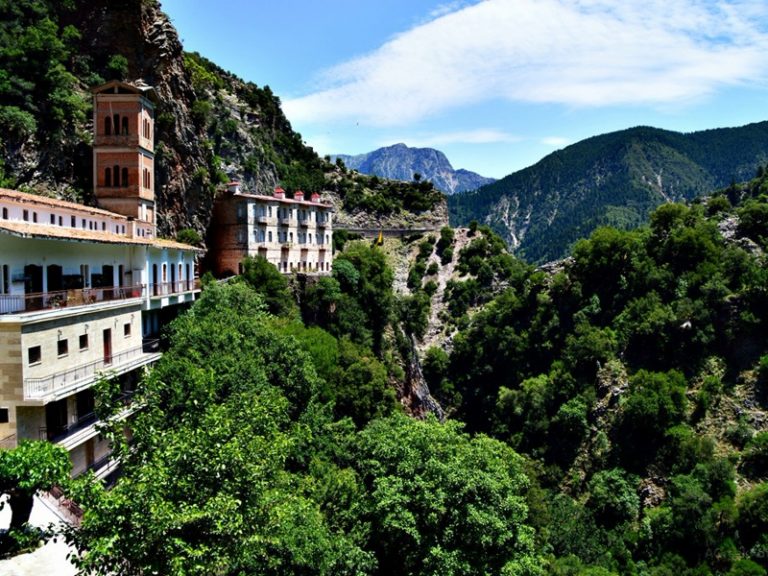
Holy Monastery of Panagia Prousiotissa in Evritania
This sacred site has a history dating back to 829 AD and is situated 35 km away from Karpenisis. Along the trail that leads to the Monastery, you can spot the "footsteps of Theotokos" (Patimata tis Panagias). According to certain beliefs, there are seven distinct shapes of varying hues, which are believed to be the imprints left by the Virgin Mary while travelling to Proussos, on the rock located there.
There is a tradition that states that the icon of the Virgin Mary, created by the Evangelist Lukas, was taken from Proussa of Asia Minor in 829 AD during the Iconomachy period to protect it from Emperor Theophilus' orders to burn Byzantine icons. A young man named Dionysios brought the icon to Greece, but for reasons unknown, the icon was missing upon his arrival in Thrace.
After Thrace, the icon appeared in Evritania, where it was revealed to a shepherd as a bright pillar that reached the sky. This happened on the 23rd of August, and this is the date when the icon is celebrated, as it was set by the Monastery where it was transferred as it was considered that this was the place where Virgin Mary chose to “reside.”
According to records of the Monastery, several parts of the icon were destroyed during the Turkish occupation. More recently, the German invasion on the 16th of August 1944 led to the complete destruction of its buildings. According to some testimonies, an officer wanted to burn the church; however, he was prevented by the “invisible hand” of Panagia, as he felt a strong power pushing him down to the floor as he was giving his orders.
The icon of Panagia Proutiotissa is miraculous, and for this reason, many believers from Greece and abroad come here all year round.
The main church, dedicated to the Dormition of the Theotokos, is in the cave. The ancient and incense-darkened Icon remains in the inner cave, surrounded by countless precious offerings. The offerings are truthful witnesses to innumerable miracles of times past and present. The village of Proussos has been built near the Monastery.
The Icon awaits the crowds of pilgrims who flock there from the 15th to the 22nd of August, which are the days of the feast.
Today the monastery is accessible by car. The car inches patiently along the winding dirt road carved on the steep mountain slope. The road from the south comes to an elevated area called Stavros. From there, the monastery can be seen perched on a recess of a precipice at the northwest corner of a narrow valley surrounded by mountain peaks. The pilgrim's patience is rewarded with a great blessing, the veneration of the Icon of the All-Holy Mother of God of Prousa.
The Sacristy of the monastery contains a wealth of valuable handwritten codes, images, holy vessels, reliquaries, and books. Many treasures are also kept in the monastery’s museum, such as images from the 15th and 16th centuries, sacred vestments, silver and gold chalices, handwritten codes, typography books and the sword of Karaiskakis.
Outside the monastery, there are two castles, one to the left and one to the right, which are called the Towers of Karaiskakis. There is also a church of Agioi Pantes, built-in 1754. Finally, there is the building that -during the Turkish occupation- housed the ‘School of the Greek Letters’, fully restored and preserved.
Today, in the Monastery there are two three-floored guesthouses for hosting pilgrims, a museum of ecclesiastical findings and objects as well as a museum of the Greek Letters of Roumeli.
The opening hours for the public are from 09.00-13.00 and from 15.00-17.00.
Tel.: (+30)22370-80726